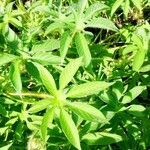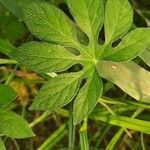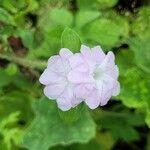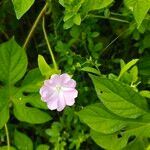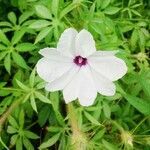Annual; stems slender or stout, trailing, up to 2.4 m. long, covered with long spreading yellow bristly hairs.. Leaf-blade palmately 7–9-lobed, often to within about 1 cm. of the base, up to 10.5 cm. long and 13 cm. wide in outline; lobes narrowly oval to obovate, narrowed above and below, subacute at the apex, 1.6–7 cm. long, 1–2.8 cm. wide, thinly hairy to strigose on both surfaces; petiole up to 14 cm. long, hairy.. Flowers in few-flowered bracteate heads; peduncle hairy, up to 14(–25) cm. long; bracts foliaceous, oblong to oblong-lanceolate, hairy outside; outer ones up to 5 cm. long and 0.6 cm. wide; inner ones narrower.. Sepals 8–10 mm. long, hairy.. Corolla white, pink or purple with darker throat, funnel-shaped, 3.5–5 cm. long; midpetaline areas with a few hairs.. Capsule brown, glabrous.. Seeds black, pubescent.
Herbs annual, twining, with spreading hispid axial parts. Stems 0.5-3 m. Petiole 2-8 cm; leaf blade circular or transversely elliptic in outline, 2-10 X 3-13 cm, palmately deeply divided; segments (3-)5-9, elliptic or oblong, tapered at both ends, densely pubescent, apex mucronate. Inflorescences capitate, few flowered; peduncle 4-11 cm; bracts hirsute; outer involucral bracts oblong to linear-oblong, 2-2.5 cm; inner bracts smaller. Pedicel obsolete. Sepals lanceolate, slightly unequal, 1-1.4 cm, hirsute on both sides. Corolla white, funnelform, 3-4 cm, midpetaline bands sparsely pubescent. Stamens included; filaments glabrous. Pistil included; ovary 2-loculed, glabrous. Stigma 2-lobed. Capsule ovoid, ca. 7 mm, 4-valved. Seeds ellipsoid, ca. 4 mm, gray tomentellous. 2n = 28, 30.
Leaf lamina circular to somewhat reniform in outline, palmately-pedately 7–9-lobed, 4–11 × 4–15 cm., in outline, broadly cordate at the base; lobes narrowly oval to obovate, narrowed above and below, acute or subacute, minutely mucronate at the apex, narrowed and confluent at the base, 1·5–7·5 × 1–2·5 cm., lateral ones gradually smaller, lowermost somewhat oblique to falcate, often obtuse, all thinly hairy to strigose on both surfaces; sinises between the lobes rounded; petiole up to 14 cm. long.
Stems slender or more or less stout, trailing, up to 3 m. long, occasionally prostrate covered with long spreading yellow bristly hairs as are petioles and peduncles, up to 2 m. long.
Flowers in few-flowered bracteate heads; peduncle up to 15 cm. long; bracts foliaceous, oblong to oblong-lanceolate, hairy outside; outer ones up to 3 × 0·8 cm., inner ones smaller.
Corolla funnel-shaped, white, pink or purple with darker throat, 3–5 cm. long; midpetaline areas with a few hairs.
Pink or red-purple flowers 1 in. or more long in pedunculate bracteate heads.
Sepals lanceolate, 7–12 mm. long, hairy.
Annual or sometimes perennial herb.
Capsule ovoid, glabrous.
Seeds brown, pubescent.
Coarsely hairy twiner
Deeply divided leaves

